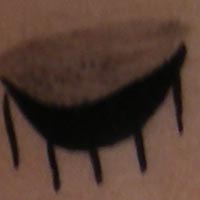Nikon Coolpix S10 Review
Review Date: February 26th 2007
Author: Gavin Stoker
Leave a comment about this Review
|
Image Quality
All of the sample images in this Review were captured using the 6M High (2816 x 2112) JPEG image size option producing a file that is between 1.5-2.5Mb.
Noise
The Nikon Coolpix S10 has 5 ISO settings. Noise creeps in visibly from ISO 400, and at top ISO 800 it's noticeably grainy, but I'd argue, not unusable if you're pushed. Still, a 'could do better'. Here are some 100% crops which show the noise levels for each ISO setting.
ISO 50 (100% Crop) |
ISO 100 (100% Crop) |
 |
 |
ISO 200 (100% Crop) |
ISO 400 (100% Crop) |
 |
 |
ISO 800 (100% Crop) |
|
 |
Sharpening
Here are two 100% crops which have been Saved as Web - Quality 50 in Photoshop. The right-hand image has had some sharpening applied in Photoshop. The out-of-the camera images at the default setting are just a little on the soft side and benefit from some further sharpening in a program like Adobe Photoshop. Alternatively you can change the in-camera sharpening level if you don't like the default results.
Original
(100% Crop) |
Sharpened (100% Crop) |
 |
 |
 |
 |
Chromatic Aberrations
On close inspection there is some purple fringing visible between areas of high contrast, though the Nikon Coolpix S10 handles this perennial problem better than some competing compacts. Here is a 100% crop which shows the typical chromatic aberrations that you can expect:
| Chromatic
Aberrations (100% Crop) |
Chromatic
Aberrations (100% Crop) |
 |
 |
Macro
The Nikon Coolpix S10 offers a Macro setting that allows you to focus on a subject that is 4cms away from the camera. The first image shows how close you can get to the subject in Macro mode (in this case a compact flash card). The second image is a 100% crop.
| Macro Shot |
Macro Shot (100% Crop) |
 |
 |
Flash
The flash settings on the Nikon Coolpix S10 areAuto, Auto with Red-Eye Reduction (In-Camera Red-Eye Fix), Anytime Flash, Flash Cancel, and Slow sync. These shots of a white coloured wall were taken at a distance of 1.5m.
| Flash Off - Wide Angle (38mm) |
Auto Flash - Wide Angle (38mm) |
 |
 |
| Flash Off - Telephoto (380mm) |
Auto Flash - Telephoto (380mm) |
 |
 |
And here are some portrait shots. As you can see, both the Flash On setting and the Red-Eye Reduction option caused a small amount of red-eye.
| Flash On |
Flash On (100% Crop) |
 |
 |
| Flash - Red-Eye Reduction |
Flash - Red-Eye Reduction (100% Crop) |
 |
 |
Night Shot
The Nikon Coolpix S10 maximum shutter speed is 2 seconds in Long Shutter Mode, which is not very good news if you're interested in night photography. The shot below was taken using a shutter speed of 1 second, aperture of f/3.5 at ISO 800. I've included a 100% crop of the image to show what the quality is like.
| Night Shot |
Night Shot (100% Crop) |
 |
 |
Overall Image Quality
Like other current Nikon compacts, the Coolpix S10 has trouble getting sharp images in less than perfect light, though with VR on constant activation, the S10, for me, delivered much better results than the (VR lacking) S9 under similar conditions. However, if in doubt, the Nikon S10 is over keen to fire the flash to compensate, which is thermonuclear in its intensity. Even when the built-in flash is used, the S10 doesn't always get it right when pre-focusing the shot, and I found it trickier than it should be to achieve a sharply focused image under artificial light. That's slightly frustrating as the Nikon Coolpix S10 would be great for using at pop concerts, shooting over the heads of the throng (doubtless much to your neighbours' annoyance) or from the press photographers pit. Almost one out of every two images was blurred even when flash was used, and it's also well worth using the red eye reduction setting on the flash, seeing as the bulb is situated slap bang alongside the lens. If you turn off the flash indoors and utilise a mixture of filtered daylight and ISO, the performance isn't too bad. Noise creeps in visibly from ISO 400, and at top ISO 800 it's noticeably grainy, but I'd argue, not unusable if you're pushed. Still, a 'could do better'. The Nikon S10 undoubtedly functions better outdoors, choosing to underexpose to preserve detail if it's bright. On close inspection there is some purple fringing visible between areas of high contrast, though the S10 handles this perennial problem better than some competing compacts. At maximum wideangle verticals do begin to lean and bend, but again this is no worse than illustrated by rivals. Colours were a bit cool for my liking left on standard setting, with the vivid option lending some much needed pep on a dull day, though of course these could always be boosted in Photoshop. Overall, although sharp, crisp images are achievable on brighter days, the overriding impression is that you have to work harder to get images you'd want to keep out of the Nikon Coolpix S10 than you should have to – given its point-and-shoot status.
|
![]() PhotographyBLOG
is a member of the DIWA
organisation. Our test results for the Nikon Coolpix S10 have
been submitted to DIWA
for comparison with test results for different samples of
the same camera model supplied by other DIWA
member sites.
PhotographyBLOG
is a member of the DIWA
organisation. Our test results for the Nikon Coolpix S10 have
been submitted to DIWA
for comparison with test results for different samples of
the same camera model supplied by other DIWA
member sites.
